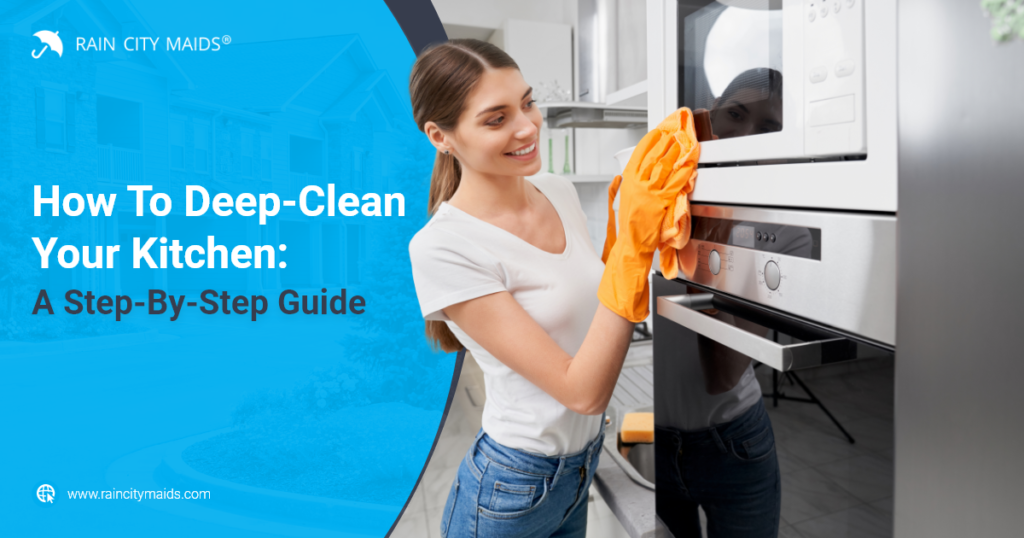When was the last time you gave your kitchen a deep clean? While it's easy to keep up with daily tasks like mopping the floor and wiping down countertops, tackling a comprehensive kitchen cleaning session is essential to maintain a pristine and hygienic space.
With grease stains and food residue constantly accumulating, a monthly deep cleaning routine becomes a necessity for most households. In this blog post, we'll guide you through a step-by-step process to deep-clean your kitchen effectively. From tackling stubborn grease to organizing cabinets, we'll cover all the essential tasks to ensure your kitchen shines.
And if you're looking for more comprehensive cleaning tips to transform every corner of your home, be sure to explore our complete room-by-room cleaning guide, where we share expert advice for maintaining a spotless home environment. So, let's dive in and discover the secrets to a sparkling kitchen. And if you're craving a pristine home environment but need a helping hand, stay tuned for our recommendations on thorough maid services that will leave your home immaculate from top to bottom.
Do a quick pre-cleaning and decluttering
Cleaning a cleared and organized room takes less time. Before properly deep cleaning the kitchen, do a quick decluttering and dusting. Pick up anything that doesn't belong to the kitchen and put it in a basket. Also, store food supplies in the pantry and the kitchenware in their allocated cabinet. With a duster or a microfiber cloth, dust the ceiling fans, light fixtures, cabinets, and outside the appliances. You can dust the art and photos hanging on your kitchen walls too. Vacuum or wipe your window sills and blinds. If you have curtains, use the vacuum cleaner on them.
Deep-clean the kitchen appliances
Deep cleaning the kitchen mostly means cleaning the large and numerous kitchen appliances. We tell you here the general steps. However, it is important to carefully read the manufacturer's instructions and precautions before cleaning the devices and appliances.
Refrigerator and freezer
Take everything out of the appliance. You can wipe inside the device with a mix of hot water and two tablespoons of baking soda. Spray the mixture and wipe the drawers and shelves. Also, this is the perfect moment to organize and discard food waste. Do you want to get rid of foul smells inside the fridge? Leave a cup of plain baking soda, and it will absorb the odors!
Stovetop
Cleaning the stovetop often means dealing with grease stains and other food residues. First, remove the burner grates and burner caps and soak them in warm soapy water. With a cloth, remove crumbs, debris, and any loose dirt from the stovetop surface. Scrubbing the tough areas is different depending on the type of stovetop you have:
- For glass stovetops, use damp microfiber cloths or a textured sponge.
- For electric stovetops, use a non-abrasive cloth or sponge.
- For gas stovetops, you can use an abrasive sponge or scrubbing brush.
Lastly, wash the burner grates and caps. Let them dry before assembling them on the stove.
Oven
Ovens usually have a self-cleaning feature. However, before using this option, you should remove crumbs and built-up grease to avoid fire hazards. First, remove the racks inside the oven to wash them. Then, use a damp cloth to clean the surfaces. If there are hard-to-remove grease stains, you can use your degreaser or other cleaning products.
Microwave
First, take the removable plate out of the microwave and wash it with dish soap and water. To clean inside the microwave, use a damp cloth.
Dishwasher
Many dishwashers are self-cleaning too. Before running the auto-clean feature, take out any rack, filter, or anything that is removable inside the dishwasher. Wipe grime and debris inside the device. If your dishwasher doesn't have a self-cleaning option, run a hot water cycle but leave a bowl with one cup of vinegar inside the appliance. Lastly, run another cycle but sprinkling a cup of baking soda in the bottom of the dishwasher.
Disinfect the countertops and sink
Wiping the visible dirt in the countertops and sink is not enough; you'll have to disinfect them. For the countertops, wiping with a sanitizing solution will do the work. However, be careful and use the proper cleaner depending on the material. For tiled surfaces, you can use a small brush to scrub the grout until it is spotless.
Use the cleaners you regularly use for wiping your sink's basin. You can scrub steel, but scrubbing can scratch the surface of a granite or glass sink. Use your household disinfectant to pour in the sink drain and sanitize it. If you are looking for a greener option, use half a cup of baking soda and half a cup of white vinegar. Sprinkle the baking soda in the drain and pour the vinegar. Let it rest for 15 minutes before rinsing with warm water. Lastly, wipe the faucet and its handles with a disinfectant wipe.
Reorganize and clean cabinets and drawers
To truly deep-clean your kitchen, you should take the kitchenware out of the cabinets and drawers and empty the pantry. Use a microfiber cloth to clean the debris or dust that could have reached the interior of the pantry and other cabinets. Use this moment to reorganize and discard the things that don't serve you, like expired food and clutter.
Clean the floor
As in any other room, the last thing you should clean in the kitchen is the floor. Begin by sweeping or vacuuming the floor. Then, wash the kickboards, focusing on cleaning the stains. Lastly, mop the floor as you usually do.
What's next after cleaning the kitchen? Check here a complete room-by-room guide! And if you need a hand in your household chores, let Rain City Maids help you. Learn more about our cleaning services.
